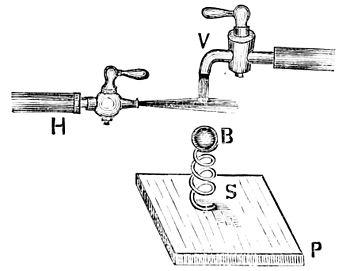the force of the jet. In that position the ball resembles a sphere exposed to atmospheric pressure above and below.
Now, let an horizontal jet of water H be thrown against the vertical jet V, as shown in Fig. 3, and its action, opposed to the spring S, must cease at once, and the unbalanced pressure of the spring raise the ball into the position shown in Fig. 3.
The situation of the ball in Fig. 3 is now equivalent to that in Fig. 1, where the air-jet J, passing over one side of the ball, calls into action the pressure D at right angles to the jet. Were the sphere B in Fig. 1 placed in the centre of the jet, no such action could result; and, if the ball were placed there, its gravity would be un-balanced until the ball fell to one side of the jet, and the supporting power of the air evoked.

Fig. 3.
To prove that a current of air moving parallel with any surface destroys the atmospheric pressure at that point, take a visiting-card and bend the ends at right angles with the card, so as to turn up one quarter of an inch at each end. Now place the card near the edge of a smooth table, supported by the two ends like a little bench, and try the effect of blowing violently between the card and the table in a direction parallel to both. The current will destroy the atmospheric pressure beneath the card, and the unbalanced pressure above will force the middle of the card downward. Or, take another card and fit a quill or straw tightly into a hole cut in the centre. Try to displace another card laid loosely over the first by blowing upward against it. If a pin is stuck through the centre of the second card, into the opening of the quill, to keep it from sliding off, it will be found that no effort will blow the upper card from the first, as the current of air passing out between the cards destroys the atmospheric pressure between them, calling into play a force upon their outside surfaces that presses them tightly together. The arrangement of the cards is shown in Fig. 4.
It is thus evident that a pressure perpendicular to any surface can be displaced by one acting parallel to it.

